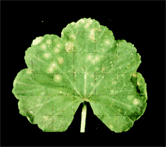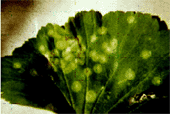Reports on Plant Diseases |
RPD No. 658 - Geranium Rust
|
January 1989
|
[ Symptoms ] [ Disease Cycle
] [ Control ]
|
Geranium rust, caused by the fungus Puccinia Pelargonii-zonalis, is a
serious disease of the florist's geranium (Pelargonium x hortorum). The
disease was first reported in South Africa in the 1920s. By the 1960s
it had spread to Australia, New Zealand, Europe, and Hawaii. Rust was
first reported in the continental United States in California and New
York in 1967. It has now been introduced into all areas of this country
where geraniums are commercially grown.
The only significant host of geranium rust is P. x hortorum. The disease
is most serious on the zonal geraniums, although it has been shown to
develop on other species. Rust is usually associated with cutting geraniums,
but seedling geraniums (P. zonale hybrid) are also susceptible. Ivy geranium
(P. peltatum), Martha Washington or regal (P. x domesticum), the scented
leaf types, or the wild geraniums are resistant. Geranium rust occurs
mainly on the leaves, but occasionally is found on petioles and stems
(Figure 1). The disease is favored by relatively cool moist conditions.
|

Figure 1.
Early stage of geranium rust on upper leaf surface .
|
SYMPTOMS
|
Small, circular, pale yellow spots first appear on the lower leaf surface.
The spots rapidly increase in diameter to 5 to 8 millimeters and turn
into rust, cinnamon brown spore pustules. Within a few days one or more
practical-to-complete, irregular concentric rings of rust-brown pustules
form around the original (Figure 2).
Small, circular yellow spots also appear on the upper leaf surface (Figure
3) opposite the pustules on the lower surface. Small pustules may form
in the center of these spots but rarely develop in concentric rings as
on the lower surface. As the number of pustules increases on the lower
surface, the spots on the upper surface turn brownish. Heavily infected
leaves turn yellow, dry, and drop prematurely often resulting in the complete
defoliation of infected plants.
|

Figure 2.
Left, concentric rust pustules on the lower leaf surface of a geranium
leaf (courtesy BASF); right, close-up of partial to complete concentric
rings of rust pustules around the original ones (courtesy Dr. F.F. Laemmlen).
|
Back to Top
DISEASE CYCLE
| The rust fungus survives as yellow-brown spores (urediospores)
in infected plants. Spores are dispersed by air currents, splashing water,
infected or infested stock, or on the hands of workers. Germination of the
urediospores and infection is optimum in moist, relatively cool (61 to 70
F or 16 to 21 C) conditions. Temperatures above 81 F (27 C) inhibit spore
germination and pustule formation. The urediospores germinate in the presence
of free water, and their germ tubes penetrate geranium leaves through the
stomates. Five to six hours of free moisture are needed for a spore to germinate
and infect a leaf. The period of incubation, from spore germination and
penetration to the appearance of the yellow spots, varies from 7 to 10 days.
An additional 7 to 9 days pass before the urediospores are released from
the newly formed pustules on the lower leaf surface. Thus, the complete
disease cycle from initial or primary infection through pustule formation
and sporulation to secondary infections may be completed every 16 to 20
days under favorable conditions. The urediospores can remain viable for
up to 12 weeks, although their viability drops off rapidly after 8 weeks. |

Figure
2. Rust spots (lesions) on the upper leaf surface of a geranium (courtesy
Dr. F.F. Laemmlen).
|
Back to Top
CONTROL
- Purchase only certified, culture-indexed cuttings from a reputable
commercial propagator. They cost a little more initially but are cheaper over
the life of the crop.
- Start new cuttings (or seedlings) in a greenhouse free of rust-infected
geraniums. If possible, have no geraniums in the greenhouse for several
weeks before bringing in new plantings for stock.
- New geraniums should be kept isolated from established greenhouse stock
plants for 3 weeks or longer and inspected frequently for the possible appearance
of rust or other diseases.
- Avoid carrying over stock plants from year to year, especially if they
are kept outdoors during the summer. Over-summered stock is especially dangerous
if other geranium growers, home plantings, or geraniums in cemeteries are
nearby. Never take cuttings from field-grown plants.
- Carefully remove all rust-infected leaves and badly affected plants on
a daily basis. Place the infected leaves and plants in a plastic bag, haul
it away from the greenhouse, and burn the contents.
- Do not move different greenhouse plant types or cuttings from one greenhouse,
section, or area to another in an infected house because rust spores may adhere
to these plants.
- After the growing season is over remove all remaining geranium plants and
discard them in an area at least a half mile from the greenhouse. Carefully
clean up and destroy all geranium debris. Steam-sterilize cutting and growing
benches and fumigate the house. These practices should eliminate any viable
rust spores in the greenhouse. It is best not to grow geraniums for longer
than 3 to 6 months in the same greenhouse.
- Keep the humidity in the greenhouse at 80 to 85 percent or less by increasing
air movement and adding heat as temperatures fall to prevent moisture condensing
on the foliage.
- Practice only surface watering. Avoid splashing water in the foliage. If
overhead watering is necessary, water in the morning on a rising temperature
so the foliage will dry quickly.
- Space the plants far enough apart to allow for good air circulation.
- A combination of cultural and chemical controls are often required to control
geranium rust. Contact fungicides should be thoroughly applied as sprays or
dusts at 7- to 10-day intervals starting when rust is first evident; systemic
fungicides can be applied at 2- to 4-week intervals. For suggested fungicides
to use, refer to Illinois Commercial Landscape and Turfgrass Pest Management
Handbook or the Illinois Home, Yard and Garden Pest Guide. Always carefully
follow all label directions and precautions.
Back to Top
For further information concerning
diseases of crucifers and other vegetables, contact Mohammad Babadoost, Extension
Specialist in Fruit and Vegetable Diseases, Department of Crop Sciences, University
of Illinois at Urbana-Champaign. University
of Illinois Extension provides equal opportunities in programs and employment.
|



